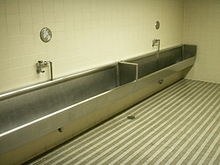Pee gutter
A pee channel is a urinal for simultaneous use by several people and is mainly used in public lavatories or restaurants . Occasionally the term pissoir (French origin) is used for it; The name in the standard work Bauentwurfslehre is Pißstand , commonly known as it is often called Pissrinne or Pinkel wall called.
Design and use
The classic pee channel is an inclined recess in the tiled floor, which is usually located in front of a wall that is also tiled. There are also seldom variants in which the floor in front of the pee channel is provided with a grille to absorb misdirected rays. Gutters are also used that do not run on the floor, but at about knee / thigh level. In addition to tiles, porcelain, stainless steel or enamelled surfaces are also used as materials.
When using it, you do not urinate in the gutter itself, but against the tiled or waterproof painted wall. A comparatively large surface is wetted, which on the one hand increases the stench and on the other hand increases the water consumption required for flushing .
The rinsing takes place either through water outlets on the wall, which cover the entire surface as far as possible, or through a tap at one end of the channel, which constantly or periodically flushes water to a drain at the other end. The flush can be triggered by a time control (in schools often connected with the bell that divides the lesson times) or motion detectors when in use. Individual rinses are often not available.
At major events, such as the New York City Marathon , pee channels with a length of several hundred meters are sometimes used. In many cases, improvised pee channels are erected for this purpose, which are created by attaching water-impermeable panels to an existing fence with drainage channels underneath (mostly already existing). This is particularly intended to prevent wild urination on the surrounding property.
Peeing channels are mainly used in men's toilets, but also by women at major events, with the aid of a urinella .
Advantages and disadvantages
The advantages of the pee trough are comparable to those of the urinal, which means that men can use it in a standing posture so that no physical contact with the trough is required. In addition, the pee trough can also be used equally well by men of different heights (e.g. in schools with students of a large range of ages and sizes), which often causes difficulties with the urinal.
One advantage of the pee channel compared to the single urinal is that more people can urinate at the same time given the size of the system, which is an important advantage for large events with large numbers of visitors. The relatively large and smooth surfaces of a pee channel make cleaning easier, and unlike a number of urinals, there are fewer nooks and crannies in which dirt can accumulate.
Disadvantages are the significantly higher water consumption compared to the urinal, the poor odor trap and the increased risk that the floor and clothing in a wide area of the user will be soiled by urine splashes. Furthermore, pee channels do not offer any discretion, which is a considerable burden for paruretics . Only in older, representative buildings (e.g. concert halls) are pee channels with individually shaped “squares” with their own drainage, which can just as easily be described as floor-reaching urinals.
literature
- Otto Kruse: Expertise for tilers . 6th edition. Springer Fachmedien, Wiesbaden 1999, ISBN 978-3-663-10026-3 , p. 196 ff.
Web links
- About rustic urinals and inviting basins. handelsblatt.com; accessed on February 11, 2016


